Don’t Live With Tooth Pain Any Longer
Root canal therapy saves a tooth that’s become infected or damaged due to deep decay or trauma. While many patients are apprehensive about root canal treatment due to its reputation, it’s a safe and effective way to restore oral health and maintain natural teeth.
In this comprehensive guide, our Loveland, OH, dentist explains the basics of root canal treatment to help patients prepare for treatment and feel more at ease going into their procedures. Contact our dental office today by calling (513) 677-3656 to schedule an appointment.
What Is Root Canal Therapy?
Root canal therapy, also known as endodontic treatment, is a dental procedure used to remove the infected pulp (the soft tissue inside the tooth) and clean and shape the root canals. The root canals are then filled and sealed to prevent bacteria from reinfecting the tooth. This helps save the tooth and prevent further damage or infection.
Each tooth has a soft inner layer known as the pulp, which consists of blood vessels, connective tissue, and nerves. The pulp extends from the crown of the tooth to the tip of the root(s) in the jawbone. When the pulp becomes infected or damaged due to deep decay, repeated dental procedures, or trauma, it can lead to severe pain, sensitivity, swelling, and even tooth loss if left untreated.
Anatomy of a Tooth
To better understand root canal therapy, it’s essential to know the anatomy of a tooth. Each tooth consists of three main parts:
- Crown: The crown is the visible part of the tooth above the gum line. It’s covered by a protective layer called enamel, which is the hardest substance in the human body.
- Dentin: Beneath the enamel lies the dentin, a yellowish layer that forms the bulk of the tooth structure. Dentin isn’t as hard as enamel but still provides support and protection.
- Pulp: The innermost part of the tooth is known as the pulp. It contains nerves, blood vessels, and connective tissues, playing a vital role in tooth development during childhood. The pulp extends from the crown to the root tips, residing in the pulp chamber and root canals.
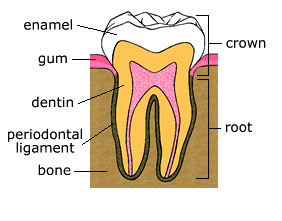
Healthy tooth
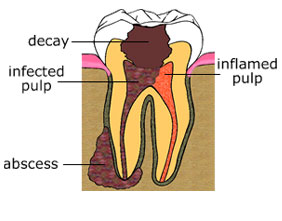
Tooth in need of root canal
The way root canal therapy is performed today is vastly different than those done a few years ago, not to mention a decade ago. The potential level for quality care has dramatically increased. It’s a thing of the past to do root canals in five to six appointments, or by “touch or feel” because we could not see. Root canals can be done painlessly, faster, and more accurately due to the new technology available.
When Is Root Canal Therapy Necessary?
Root canal therapy may be necessary for several situations, including:
- Dental Decay: When left untreated, a cavity can spread to the tooth’s pulp and cause infection. called pulpitis. This can lead to severe pain, swelling, and potential tooth loss if not addressed with root canal treatment.
- Dental Trauma: A tooth that’s been fractured or chipped can allow bacteria to enter the pulp and cause infection, requiring root canal therapy to save the affected tooth.
- Gum Disease: Advanced gum disease (periodontitis) can cause pockets around the tooth, allowing bacteria to enter and infect the pulp, making a root canal procedure necessary.
Root canal therapy is often the best way to treat these issues and prevent further damage to the tooth and surrounding tissue. Contact our top-rated dentist today.
Signs of Dental Infection
If you’re experiencing any of the following symptoms, you may have a dental infection that requires root canal therapy:
- Severe, persistent toothache or throbbing pain
- Sensitivity to hot or cold temperatures and liquids
- Swelling and tenderness in the gums around the affected tooth
- Discoloration or darkening of the tooth
- Pain when chewing or biting down
- Presence of a pimple-like bump on the gums near the affected tooth
If you’re experiencing any of these symptoms, schedule an appointment with Dr. Kreimer as soon as possible to receive a proper diagnosis and treatment plan.
Benefits of Root Canal Treatment
There are many benefits to undergoing root canal treatment, including:
- Saving the Tooth: Root canal therapy can help save a tooth that would otherwise need extraction, allowing you to maintain your natural teeth and avoid the need for more costly dental treatments like implants or bridges.
- Relieving Pain: Root canal therapy can help alleviate pain and discomfort caused by infection or damage to the pulp.
- Preventing Further Damage: By removing the infected or damaged pulp, root canal therapy can prevent further damage to the tooth, surrounding tissues, and bone.
- Restoring Function: With a filling in place, a tooth that has undergone root canal therapy can be fully restored and function like a natural tooth.
- Cost-Effective: Root canal treatment is often more cost-effective than extracting the tooth and replacing it with a dental implant or bridge.
Endodontic Treatments
There are several types of endodontic treatment, and the type you receive will depend on your specific dental needs. Common endodontic treatments include:
- Root Canal Therapy: This is the most common endodontic treatment and involves removing the infected or damaged pulp, cleaning and shaping the root canals, and filling them with a biocompatible material like gutta-percha. Once the root canal is filled, the tooth is restored with a permanent filling or crown.
- Apicoectomy: In some cases, root canal therapy may not be enough to treat the infection or damage to the tooth. In these cases, an apicoectomy (root-end surgery) may be necessary. This involves removing the root’s tip and any infected tissue and sealing the root to prevent further infection.
- Pulp Capping: If the damage to the tooth is minor and hasn’t caused an infection, your dentist may recommend a pulp capping procedure. This involves placing special material over the damaged pulp to help it heal and prevent further damage.
- Regenerative Endodontics: This newer type of root canal therapy helps the damaged pulp in young teeth heal and regenerate. This involves using special materials to stimulate the growth of new pulp tissue and blood vessels in the tooth.
- Root Canal Retreatment: In some cases, a tooth that has undergone root canal therapy may become infected again. In these cases, non-surgical root canal retreatment may be necessary to remove the infection and restore the tooth.
The Root Canal Treatment Process
Here’s what you can expect during a typical root canal treatment procedure:
- X-rays: Our dentist will first take an X-ray to see the shape of the root canals and determine if there are any signs of infection in the surrounding bone.
- Dental Sedation: A local anesthetic is administered to numb the tooth and nearby gums, making the procedure more comfortable for the patient. This is done to make the procedure more comfortable for the patient. If you’re extra nervous, talk to your dentist to see if they offer dental sedation options.
- Pulpectomy: A hole is drilled into the tooth to create an opening. We’ll use specialized tools to remove the pulp, bacteria, decayed nerve tissue, and related debris from inside the tooth and its root canal.
- Cleaning and Shaping: After the pulp has been removed, our dentist will clean, enlarge, and shape the canals to prepare them for the filling. This process is usually accomplished with tiny files, and a disinfecting solution may be used to kill any remaining bacteria and wash away debris.
- Filling the Canals: Once the canals are cleaned, they’re sealed with a biocompatible material, usually a rubber-like material called gutta-percha. The gutta-percha is placed with adhesive cement to ensure complete sealing of the canals.
- Temporary Filling: A temporary filling material is placed on top of the gutta-percha to close the opening until the tooth is ready for its permanent restoration. We’ll remove this temporary filling before the tooth is restored.
- Restoration: After healing, the tooth will need a permanent restoration, such as a dental crown or a filling, to replace the lost tooth structure and provide a complete seal to the top of the tooth. This step is crucial to protect the tooth from infection or breaking in the future and to restore its function.
After the procedure, your tooth may be sensitive for a few days, but over-the-counter painkillers can usually manage this. Despite its reputation, most people report the procedure is no more painful than receiving a dental filling when performed by an experienced dentist.
Step 1
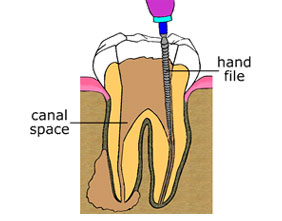
After the tooth is numbed, a small opening is made into the pulp chamber. The canals are located and measured, so they can be cleansed and shaped.
Step 2
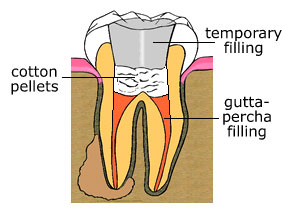
The canals are filled with a rubber-like material called gutta-percha and the opening is sealed with sterile cotton pellets and a temporary filling.
Step 3
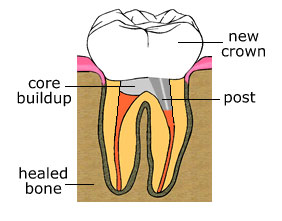
The tooth is typically restored within a couple of weeks. A dental crown is placed over the treated tooth to protect it, and if the tooth lacks sufficient tooth structure to hold the core build-up, a post may be placed inside. Any areas of infection around the roots will begin to heal.
Frequently Asked Questions
Is root canal therapy safe?
Yes! Root canal therapy is considered safe. The treatment involves removing the infected or damaged pulp from the tooth’s root canal and then filling it with a biocompatible material.
Can root canal therapy be done on any tooth?
Root canal therapy can be done on most teeth, but there may be some exceptions. Teeth with severe decay, extensive damage, or fractures may not be suitable for root canal treatment. In some cases, a tooth may need extraction instead.
How long does a root canal treatment take?
Generally, a root canal procedure can be completed in one or two visits. The duration of root canal treatment can vary depending on the tooth’s complexity and the extent of the damage. After the root canal treatment, the tooth may need to be restored with a crown or filling to protect it and restore its function.
How long does it take for a tooth to heal after a root canal?
Most patients experience some soreness or mild discomfort for a few days after a root canal treatment. However, the tooth and surrounding tissues typically heal within a week or two, and any residual pain or swelling should subside during this time.
Don’t Put Off the Treatment You Need
Root canal therapy may seem intimidating, but with the correct information and a qualified dentist, it can be a safe and effective way to treat various dental problems. By understanding what it is, how it’s done, and when necessary, you can make informed decisions about your dental health and get the care you need to keep your smile healthy and bright.
Contact our Loveland dental office at (513) 677-3656 to schedule a consultation today. Our practice warmly welcomes new and existing patients from Murdock, Landen, Mason, Reading, and beyond. Let us help you achieve your smile goals with comfortable, efficient root canal treatment and other high-quality dental services.



